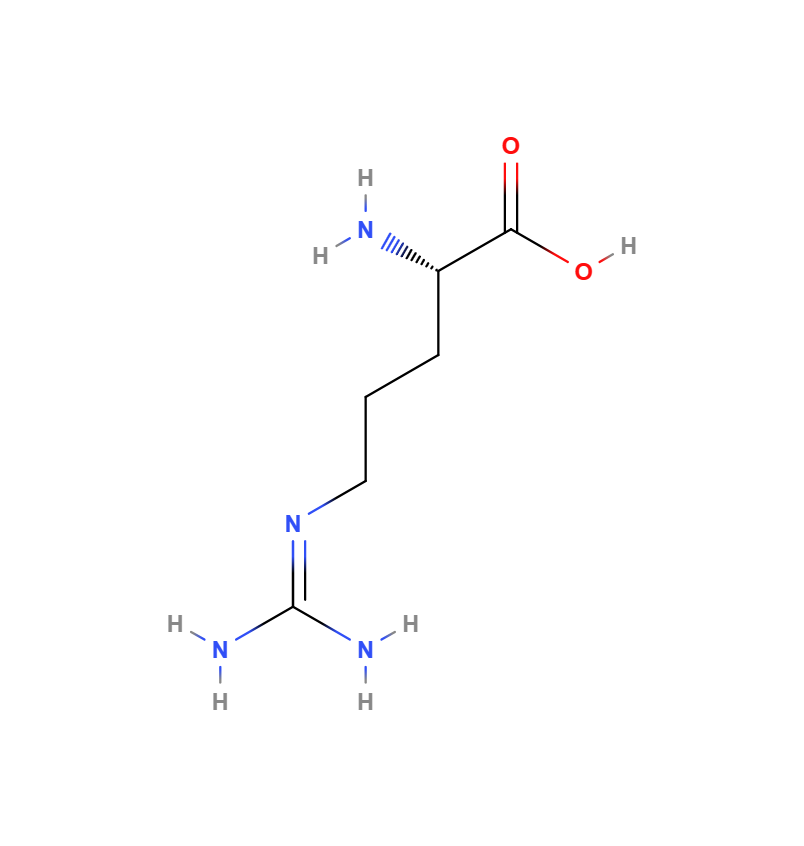ChEBI
L-arginine is an L-alpha-amino acid that is the L-isomer of arginine. It has a role as a nutraceutical, a biomarker, a micronutrient, an Escherichia coli metabolite and a mouse metabolite. It is a glutamine family amino acid, a proteinogenic amino acid, an arginine and a L-alpha-amino acid. It is a conjugate base of a L-argininium(1+). It is a conjugate acid of a L-argininate. It is an enantiomer of a D-arginine.
Descriptions
DrugBank
MeSH
1: Arginine An essential amino acid that is physiologically active in the L-form.
T3DB
Arginine is an essential amino acid that is physiologically active in the L-form. In mammals, arginine is formally classified as a semiessential or conditionally essential amino acid, depending on the developmental stage and health status of the individual. Infants are unable to effectively synthesize arginine, making it nutritionally essential for infants. Adults, however, are able to synthesize arginine in the urea cycle. Arginine can be considered to be a basic amino acid as the part of the side chain nearest to the backbone is long, carbon-containing and hydrophobic, whereas the end of the side chain is a complex guanidinium group. With a pKa of 12.48, the guanidinium group is positively charged in neutral, acidic and even most basic environments. Because of the conjugation between the double bond and the nitrogen lone pairs, the positive charge is delocalized. This group is able to form multiple H-bonds. L-arginine is an amino acid that has numerous functions in the body. It helps dispose of ammonia, is used to make compounds such as nitric oxide, creatine, L-glutamate, L-proline, and it can be converted to glucose and glycogen if needed. In large doses, L-arginine also stimulates the release of hormones growth hormone and prolactin. Arginine is a known inducer of mTOR (mammalian target of rapamycin) and is responsible for inducing protein synthesis through the mTOR pathway. mTOR inhibition by rapamycin partially reduces arginine-induced protein synthesis (A13142). Catabolic disease states such as sepsis, injury, and cancer cause an increase in arginine utilization, which can exceed normal body production, leading to arginine depletion. Arginine also activates AMP kinase (AMPK) which then stimulates skeletal muscle fatty acid oxidation and muscle glucose uptake, thereby increasing insulin secretion by pancreatic beta-cells (A13143). Arginine is found in plant and animal proteins, such as dairy products, meat, poultry, fish, and nuts. The ratio of L-arginine to lysine is also important - soy and other plant proteins have more L-arginine than animal sources of protein.
Wikipedia
Arginine is the amino acid with the formula (H2N)(HN)CN(H)(CH2)3CH(NH2)CO2H. The molecule features a guanidino group appended to a standard amino acid framework. At physiological pH, the carboxylic acid is deprotonated (−CO2−) and both the amino and guanidino groups are protonated, resulting in a cation. Only the l-arginine (symbol Arg or R) enantiomer is found naturally. Arg residues are common components of proteins. It is encoded by the codons CGU, CGC, CGA, CGG, AGA, and AGG. The guanidine group in arginine is the precursor for the biosynthesis of nitric oxide. Like all amino acids, it is a white, water-soluble solid.
HMDB
L-argininium(1+), also known as L-Arginine or DL Arginine acetate, monohydrate, is classified as a member of the L-alpha-amino acids. L-alpha-amino acids are alpha amino acids which have the L-configuration of the alpha-carbon atom. L-argininium(1+) is considered to be soluble (in water) and acidic


